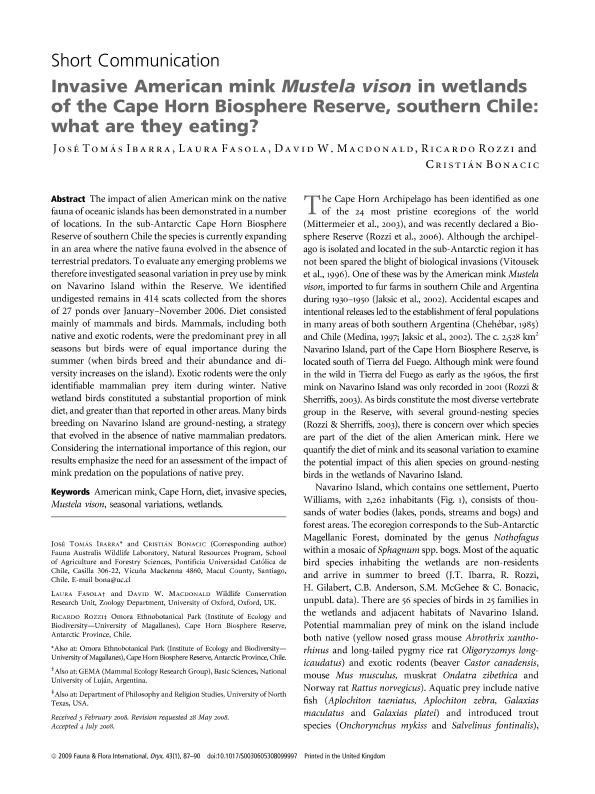Artículo
Invasive american mink mustela vison in wetlands of the cape horn biosphere reserve, southern Chile: What are they eating?
Fecha de publicación:
01/2009
Editorial:
Cambridge University Press
Revista:
Oryx
ISSN:
0030-6053
Idioma:
Inglés
Tipo de recurso:
Artículo publicado
Clasificación temática:
Resumen
The impact of alien American mink on the native fauna of oceanic islands has been demonstrated in a number of locations. In the sub-Antarctic Cape Horn Biosphere Reserve of southern Chile the species is currently expanding in an area where the native fauna evolved in the absence of terrestrial predators. To evaluate any emerging problems we therefore investigated seasonal variation in prey use by mink on Navarino Island within the Reserve. We identified undigested remains in 414 scats collected from the shores of 27 ponds over JanuaryNovember 2006. Diet consisted mainly of mammals and birds. Mammals, including both native and exotic rodents, were the predominant prey in all seasons but birds were of equal importance during the summer (when birds breed and their abundance and diversity increases on the island). Exotic rodents were the only identifiable mammalian prey item during winter. Native wetland birds constituted a substantial proportion of mink diet, and greater than that reported in other areas. Many birds breeding on Navarino Island are ground-nesting, a strategy that evolved in the absence of native mammalian predators. Considering the international importance of this region, our results emphasize the need for an assessment of the impact of mink predation on the populations of native prey.
Archivos asociados
Licencia
Identificadores
Colecciones
Articulos(CADIC)
Articulos de CENTRO AUSTRAL DE INVESTIGACIONES CIENTIFICAS
Articulos de CENTRO AUSTRAL DE INVESTIGACIONES CIENTIFICAS
Citación
Ibarra, Jose Tomas; Fasola, Laura; Macdonald, David W.; Ricardo, Rozzi; Cristián, Bonacic; Invasive american mink mustela vison in wetlands of the cape horn biosphere reserve, southern Chile: What are they eating?; Cambridge University Press; Oryx; 43; 1; 1-2009; 87-90
Compartir
Altmétricas




